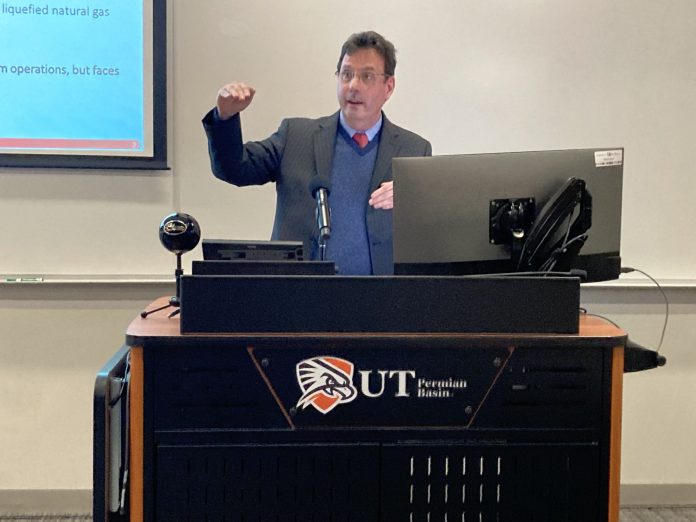
The future’s so bright for the Permian Basin, people here better find some shades, according to petroleum economists and energy executives at a Public Utility Commission of Texas workshop Tuesday.
The workshop, which featured remarks by local legislators, energy executives, organizations and economists, was held at the University of Texas Permian Basin Engineering Building.
Texas Oil and Gas Association Chief Economist Dean Foreman presented a quarterly energy economics report.
The key points of the economic backdrop for oil and gas markets he presented were:
- At the global level, U.S. and Texas levels broadly improved and shifted the outlook to a soft landing scenario with steady 2024 growth that historically has supported oil and natural gas demand growth.
- Oil markets consistent with the past reports the data have continued to show record high global demand in 2023 and 2024; global supply growth led by the U.S. and Texas; historically low U.S. crude oil ending stocks (currently at their lowest since 1985).
- Permian Basin productivity and production are key to the U.S. production outlook and have continued to set records, despite modest drilling activity, Foreman’s presentation showed.
On natural gas markets, Foreman said also consistent with past reports, domestic natural gas prices have remained historically low, thanks to strong production that has been ample to meet demand above the top of the five-year range, as well as record high reports so far in Quarter 4 of 2023. Strong production has supported working gas storage levels near the top of its five-year range, Foreman detailed.

Permian Basin associated natural gas production has also keyed record U.S. exports of natural gas.
The projected load in the Permian Basin could quadruple with more electrification of upstream operations, but faces constraints that could impact production.
From a U.S. perspective, Foreman said it comes back to the Permian Basin. He said oil and gas activity is phenomenal here.
A soft landing is predicted for 2023 followed by solid growth in 2024 and 2025.
Global demand is expected to set record high levels in 2023 and again in 2024, Foreman said.
In the Permian Basin and other basins across Texas, productivity is strong — up almost 18 percent year over year as of December 2023.
The Permian Basin now provides more than 27 percent of total U.S. oil and natural gas production.
Compared with country level production, Texas’ combined oil and natural gas production of over 10 million barrels per day (oil equivalent energy) ranks No. 3 in the world; only the rest of the U.S. and Russia are higher.

Exports have hit record levels. Texas exported over $162 billion of energy products in the first three quarters of 2023, Foreman said.
Many Permian producers have installed their own generation capacity, including diesel generators and renewable but raises costs and generally is less efficient than utility scale provision.
If firms are unable to dedicate capital to electricity generation, the regional limitations on generation and transmission could impede investment and production which most energy modeling assumes will occur without friction in the long run, Foreman said.
Curtis Smith, director of research, upstream consulting for IHS Markit, said although there was a production decrease in 2020 due to the pandemic, historical oil production is exceeding its forecast of 18 months ago validating its conservative views of the future production outlook.
Smith said the long-term outlook is not likely to change since its resource base of 71 billion barrels supports it.
Industrial load demand is forecasted to grow significantly. The load is not meeting current needs.
Production increases are forecasted to continue.
Operators and midstream companies are intending to use the grid as a long-term solution to emissions reductions, Smith said.
House Bill 5066, passed by the Texas Legislature this year and signed into law by Gov. Greg Abbott, instructed the PUCT and the Electric Reliability Council of Texas (ERCOT) to develop an electric reliability plan for the Permian Basin that addresses transmission needs in the region, additional capacity needed to meet the power demands of the energy industry, and streamlining interconnection processes. The workshop brought together PUCT officials, oil and gas associations, and transmission service providers from around the state to discuss challenges unique to the region and how both industries can work together to ensure both reliability and continued economic growth in the Permian Basin’s energy sector.



